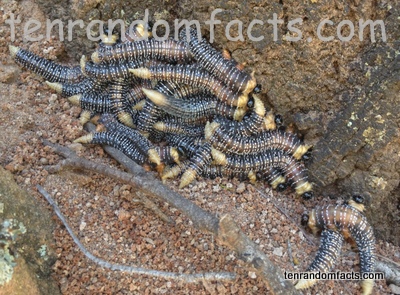Tap… Tap, Tap, Tap… TapTapTapTapTapTapTap
- Spitfire grubs look similar to the caterpillars of buttterflies and moths, however they are the larvae of a species of sawfly, the adult having a saw-like egg laying system, and are a relative of the wasp.
- Spitfire grubs, also known as ‘sawfly larvae’, are an Australian species of Perga from the sub family Perginae, from the family Pergidae (sawflies), which comes from the order of Hymenoptera, which includes sawflies, wasps, bees and ants.
- Spitfire grubs are the babies of the sawfly species that includes the Steel Blue Sawfly (Perga dorsalis), Large Green Sawfly (Perga affinis), and the Eucalyptus Sawfly (Perga kirbyi), and the adult sawflies are rarely seen and are said to only live for about a week.
- The most well known spitfire grubs, the Steel Blue Sawfly larvae, have black bodies and white hairs, with yellow ‘tails’ and a shiny black head, and the Large Green Sawfly larvae also look the same.
- Spitfire grubs are herbivores and generally eat the leaves from Eucalyptus trees, and can sometimes strip the tree of all its leaves, although some species feed on Melaleuca, Callistemon and Angophora trees.
- Spitfire grubs are said to be harmless although they can kill a young tree by eating all of its foliage, and the adult sawfly does not sting.
- Spitfire grubs feed during the night, usually alone, and during the day they cluster together in large groups of 20-30 (sometimes more) as a defence against potential predators.
- Spitfire grubs have three pairs of front legs, and none at the back, with a ‘tail’ that they thump up and down or tap, with which they use to communicate to others in the group.
- Spitfire grubs grow up 80 mm (3 inches) in length and when they have finished growing they burrow into the soil to pupate and become an adult sawfly.
- As a defence, spitfire grubs squirt from their mouths a yellow liquid made from eucalyptus oil then they are attacked or threatened, hence the name ‘spitfire’.





